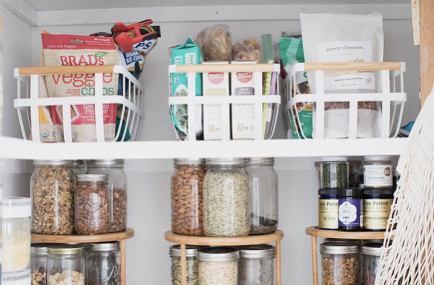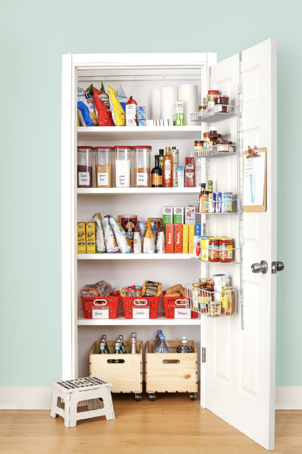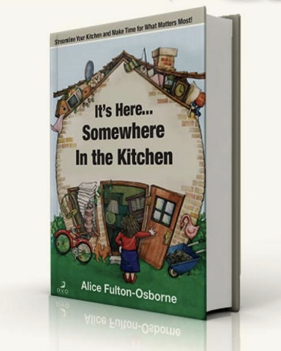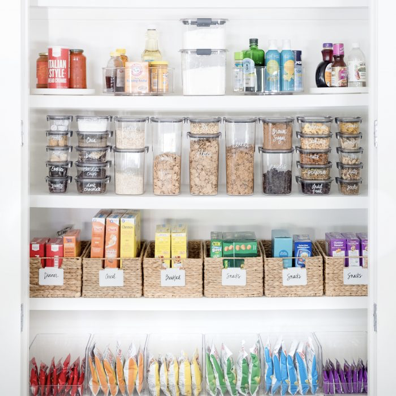Best Pantry Practices: (Not Hinged on SIZE or Location)!
We’ve talked off and on over the years about what a well-stocked pantry ought to house. My strong opinion is that no matter what we at DVO or anyone else out there in cyberspace says, YOU are really the one to decide that. It all hinges on your dietary needs, your personal tastes and preferences, your interest-level in cooking, and especially the time you have for cooking. So I won’t waste time banging the “well-stocked pantry” drum.
BUT, I will bang the “best pantry practices” drum. I’m referring to how it’s set up. And know this: Good organization is never dependent on SIZE! A very efficient pantry can be as small as a couple cupboards—you don’t need the fancy-shmancy walk-in types you see in Martha Stewart’s Living magazine.

And don’t get hung up on location. A very efficient pantry can be a converted linen closet that’s around the corner and down the hall from the kitchen.
So with the size- and location-myths out of the way, let’s talk about fool-proof best pantry practices—practices that create a pantry that serves you, rather than works against you. (Drum roll here…) It should only hold what you actually like, use, need, want, and have room for. The pantry is the spot for 2- to 3-week’s worth of provisions. It’s not the spot for long term storage, so you don’t want to put bulk sized bags and boxes in a pantry. They go somewhere else—a food storage area, if possible. You transfer smaller amounts into pantry-sized containers instead.
Here are some compelling reasons to get this space organized (they validate what WHY to store only what you actually like, use, need, want, and have room for):
You’ll save money by identifying what you're truly using, what you're not using and what you've bought in duplicate (or in same cases, triplicate). This practice stretches the grocery dollar.

Related to the above, you’ll get a clear picture of your cooking habits. I read about a newbie cook who, with enthusiasm, bought some saffron (which we know is very, very expensive). It sat in her pantry and moved with her, unopened, to 2 different apartments. When she finally organized her pantry, she found it and tossed it, realizing she was still a beginner cook and had only bought the saffron because she thought it was the right thing to do. (Haven’t we all done this?) It’s easier to see what’s real when spaces are organized.
And related to both points, you’ll get a clear picture of what you should be buying, and how much. The main idea is to buy what you eat and eat what you buy. Then store it in an organized way, and your pantry works FOR you rather than AGAINST you.

Finally, getting the pantry in shape is a great way to launch into a new year of Cook’n! The fact is, when things are easier to do, we tend to do more of them. Working out of an organized pantry is incentive enough to cook more!
Now let’s talk about smart pantry arranging—arranging what you like, use, need, want, and have room for—the actual organization piece. You can find very detailed directions on all this in my DVD, It’s Here…Somewhere in the Kitchen. I talk about “grouping and storing like items together”—the supermarket principle of organization. The plan is to create a mini-supermarket in your own home, if you will.

For example, consider grouping all vinegars together: champagne, apple cider, balsamic, rice wine, and cooking wines. Grouping them together means no more hunting around for things, wasting valuable time and energy. This practice also means it’s easier to put things away, because now “away” makes sense. Other common groupings:

What would you add or subtract from these lists? You get the point though—things are grouped together in categories. This “supermarket system” of organization has been around since the first general store, and for good reason—it works well.
So whatever you decide goes in your pantry, just be sure you put rhyme and reason into its arrangement, the way the grocery stores do.
Implementing these best pantry practices is well worth your time. Smart pantry arranging will not only save time and energy, it’ll be a great incentive to cook more. And isn’t this something you’d like to do more of in 2020?
BUT, I will bang the “best pantry practices” drum. I’m referring to how it’s set up. And know this: Good organization is never dependent on SIZE! A very efficient pantry can be as small as a couple cupboards—you don’t need the fancy-shmancy walk-in types you see in Martha Stewart’s Living magazine.

And don’t get hung up on location. A very efficient pantry can be a converted linen closet that’s around the corner and down the hall from the kitchen.
So with the size- and location-myths out of the way, let’s talk about fool-proof best pantry practices—practices that create a pantry that serves you, rather than works against you. (Drum roll here…) It should only hold what you actually like, use, need, want, and have room for. The pantry is the spot for 2- to 3-week’s worth of provisions. It’s not the spot for long term storage, so you don’t want to put bulk sized bags and boxes in a pantry. They go somewhere else—a food storage area, if possible. You transfer smaller amounts into pantry-sized containers instead.
Here are some compelling reasons to get this space organized (they validate what WHY to store only what you actually like, use, need, want, and have room for):
You’ll save money by identifying what you're truly using, what you're not using and what you've bought in duplicate (or in same cases, triplicate). This practice stretches the grocery dollar.

Related to the above, you’ll get a clear picture of your cooking habits. I read about a newbie cook who, with enthusiasm, bought some saffron (which we know is very, very expensive). It sat in her pantry and moved with her, unopened, to 2 different apartments. When she finally organized her pantry, she found it and tossed it, realizing she was still a beginner cook and had only bought the saffron because she thought it was the right thing to do. (Haven’t we all done this?) It’s easier to see what’s real when spaces are organized.
And related to both points, you’ll get a clear picture of what you should be buying, and how much. The main idea is to buy what you eat and eat what you buy. Then store it in an organized way, and your pantry works FOR you rather than AGAINST you.

Finally, getting the pantry in shape is a great way to launch into a new year of Cook’n! The fact is, when things are easier to do, we tend to do more of them. Working out of an organized pantry is incentive enough to cook more!
Now let’s talk about smart pantry arranging—arranging what you like, use, need, want, and have room for—the actual organization piece. You can find very detailed directions on all this in my DVD, It’s Here…Somewhere in the Kitchen. I talk about “grouping and storing like items together”—the supermarket principle of organization. The plan is to create a mini-supermarket in your own home, if you will.

For example, consider grouping all vinegars together: champagne, apple cider, balsamic, rice wine, and cooking wines. Grouping them together means no more hunting around for things, wasting valuable time and energy. This practice also means it’s easier to put things away, because now “away” makes sense. Other common groupings:
- Canned goods (soups together, veggies together, beans together, etc.)
- Bags of snack foods
- Containers of herbs and spices (they need to be tossed after a year, so use ‘em up!)
- Containers of grains such as oats, rice, cereals (to prevent weevil infestation—grrrr—consider freezing these for a day or two before adding them to your pantry)
- Sweeteners (honey, maple and agave syrups, brown sugar, white sugar, powdered sugar, stevia, etc.)
- Fats (coconut oil, olive oil, grapeseed oil, etc)
- Milks (coconut, powdered, canned, sweetened condensed, almond, rice, etc.)
- Containers of pastas
- Tomato products (canned tomato sauce and paste, canned stewed and diced tomatoes, salsa, ketchup, etc.)
- Proteins (nut butters, canned tuna, salmon, chicken, etc.)
- Dried legumes (bean varieties, lentils, split peas, etc.)

What would you add or subtract from these lists? You get the point though—things are grouped together in categories. This “supermarket system” of organization has been around since the first general store, and for good reason—it works well.
So whatever you decide goes in your pantry, just be sure you put rhyme and reason into its arrangement, the way the grocery stores do.
Implementing these best pantry practices is well worth your time. Smart pantry arranging will not only save time and energy, it’ll be a great incentive to cook more. And isn’t this something you’d like to do more of in 2020?
Sources:
- www.wellandgood.com
- www.azbio.org
- www.goodhousekeeping.com
- www.thehomeedit.com
 Alice Osborne
Alice Osborne
Weekly Newsletter Contributor since 2006
Email the author! alice@dvo.com
